Stories about weapons. Motobronevagon MBV-2
But only if the rails were laid in the right direction. This is how the practice of the First World War showed.
But at the same time, armored trains were autonomous. Even too much. Having practically no connection with the rest of the units and formations, they often found themselves alone with the enemy, and such an opposition was not always successful for armored trains.
Whatever the firepower of the armored train, the size of the composition and the possibility of its movement dramatically reduced the protective capabilities of the entire system and made the train prey to the enemy's field batteries.
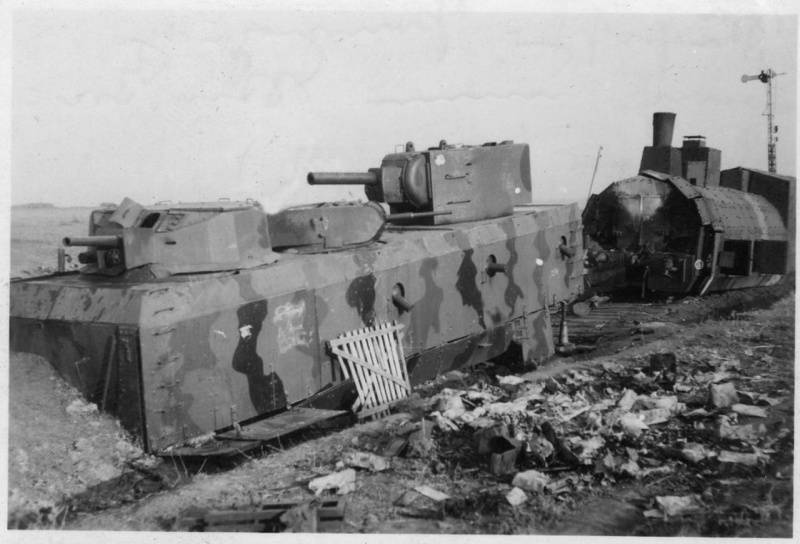
In World War II aviation...
And of course, there was an acute question of coordination. Radio communication in trains has not yet been registered (we are still talking about the First World War), and the capabilities of the station telegraph as a method of communication with trains were conditional, since the telegraph worked from station to station.
He played the role and weight of the armored train. The fact is that it was the great weight of the composition that made it impossible to use this weapon everywhere. Not all branches and roads could normally “hold” an armored train. The canvas just collapsed under the train. Add to this the railway bridges ...
Thus, the use of assault armored trains revealed the need for the emergence of the next generation of railway armored vehicles. And to be more precise, armored trains identified two lines for the further development of railway armored vehicles.
First, they needed light and fast armored rubber to carry out reconnaissance tasks and communications with staffs. These cars should be fast, armored with anti-bullet armor, have minimal firepower (one or two machine guns due to the small number of crew) and, if possible, the ability to operate outside the railways.
We have already talked about such machines. Bronedrezina on the basis of the re-armored car.
Secondly, in the composition of the armored trains should be special armored cars, equipped not only with powerful weapons, but also an autonomous engine. Such cars should be used if necessary independently, autonomously.
In 1916, the first samples of the systems appeared.
The light armor "Strela" of the design of an unknown warrant engineer-engineer of the 3 railway battalion was really stunning. Starting from an exotic look, even today, not to mention the beginning of the 20 of the 20th century. And ending with decent firepower for a small car.
In the same year, the first armored car appeared. The designers of the new type of armored vehicles were Lieutenant Colonel Butuzov, ensign-technologist Tabure, and ensign-technologist Kelchitsky. The carriage was named Zaamurets.
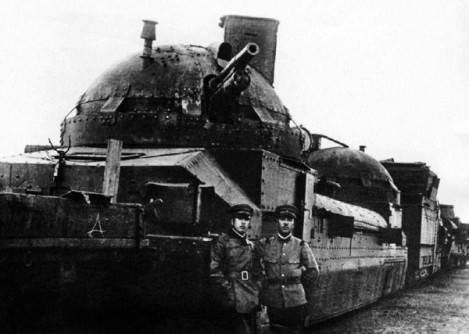
Incidentally, story the use of this armored car is so fascinating that it deserves writing a whole novel. Just a touch of history.
1917 year "Zaamurets" is used in the defense zone of the 8 Army of the Western Front at the beginning as an anti-aircraft gun, and from the end of May as a self-propelled artillery gun. In September, sent to Odessa.
January 1918. "Zaamurets" takes part on the side of the Bolsheviks in the uprising in Odessa. Engages in battle with the cadets and gaydamak from the station Odessa-Tovarnaya.
February 1918 of the Year - armored cars captured by anarchists. For a while, a gang of anarchists "collected contributions in favor of Soviet power" along the railroad.
In early March, 1918 anarchists encounter a detachment of sailor Polupanov. "Zaamurets" repulsed and included in the armored train "Freedom or death." Until May, continues to operate in the Odessa region.
In June, 1918, the "Zamuratz" was already on the Eastern Front. Participates in battles for Syzran and Bugulma. It is used successfully red.
22 July 1918 of the year in the battles for Simbirsk are thrown "Zaamurets", which hits the Czechs. Upgraded. Replacing 57-mm guns on the "three-inch" arr. 1902 of the year. Used as part of the Czechoslovak armored train "Orlik". Successfully acts on Transsib before the White Czechs leave.
Transferred by the Czechoslovak White Guards in the year 1919. He remained in Vladivostok until 1921. After which he was hijacked in Harbin, along with other White Guard armored trains. Further the track is lost.
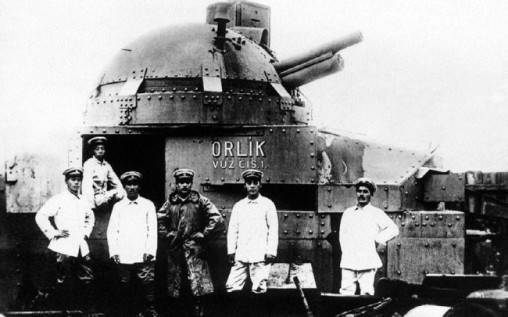
This is the background of the appearance of our today's hero. It will be about the MBV motobronovagon created in the USSR in 1936 year. Why immediately about all? Just because all of these armored vehicles was created two. Both cars have a heroic story and deserve such a story.
At the beginning of the 30-ies, it became clear that the old armored train (BP) no longer meet the requirements of the modern army. The Red Army Armored Directorate began to develop tactical and technical requirements for new machines.
These are new requirements and in June 1935 of the year were transferred to the Kirov Plant at the Special Design Bureau No. XXUMX under the supervision of O. M. Ivanov. A special design team was created headed by A. E. Efimov. which dealt directly with the armored car.
We often know only those who headed the design bureau or was the chief designer. Today we have the opportunity to remember those who directly created this car. S.P. Bogomolov, P.P. Ermolaev, L.Ye. Sychev, N.V. Chalkiolov, K.I. Kuzmin, P.P. Mikhailov, S.V. Fedorenko, P.T. Sosoev, N. T. Fedorchuk.
The second half of the 30-s in the USSR was a rather difficult period. That is why the plans were ambitious. Create an armored car to the beginning of the 1936 year! Alas, the task was impossible. And by the level of complexity of the problem, and by the level of training of engineers and designers.
The first armored car of the Kirov plant presented for testing at the beginning of November 1936. After a rather long acquaintance with the new machine of ABTU RKKA specialists, at the beginning of 1937, it was decided to start 5 000-kilometer factory tests.
And again, failure. The first January runs revealed the weakness of individual aggregates and mechanisms. Of particular concern was the chassis of the new car. In particular, the axlebox of the motor trolley. Removing flaws pushed back factory tests on February 12 1937.
But, despite the difficulties with MBE No. XXUMX, the next car was already built at the plant. The works were supervised by SKD-1 engineer F. D. Smirnov. It was planned to install new conical towers with 2-mm implements PS-76,2 on the car, to provide the possibility of moving to the West-European gauge, to strengthen the design of the gearbox and free-wheeling clutch, to seal the hull to ensure protection from toxic substances, to mount a new telephone communications, smoke suppression devices, surveillance devices and make a number of other changes.
The second armored car, MBV No. 2, was received by the representative of the Red Army on April 17, 1937. And on the same day he was sent for factory tests. BIE No. 01 was sent to the disposal of armored advanced training courses for command personnel tank troops named after Bubnov to Leningrad.
Despite the difficulties in designing and building the BIE, the command of the Red Army demanded that the Kirov factory produce an installation batch of 10 armored cars.
The plant began working in this direction at the end of the 1937 year. Were manufactured: the chassis with the engine and gearbox of the third MBV, 4 main frames still 4-x armored cars. This work was stopped.
Actually, the current model of the BIE until July 1939 was only the second carriage. However, at the end of June 1, the carriage number 1939 of the year was withdrawn from the courses and sent for modernization to the Kolomna plant. The command of the Red Army made efforts to increase the armor power of the army.
What was the motobroner of the Kirov plant? Consider it more closely.
Motobronevagon consisted of armored hull, fastened to the frame, mounted on two railway-type trolleys, connected with ball bearings and pivots. The front carriage was the support, and the rear, with the engine and transmission installed on it, was the driving one.
The armored body of the armored wagon was welded from 10-20 mm of armor. For "better streamlining when moving" it was made "without sharp corners with smooth transitions."
The body of the moto armor car was installed on the main frame riveted from sheet and profile iron. It was based on two longitudinal beams, riveted to each other with transverse mounts. From above, the frame was closed with metal sheets, in which a cutout was made above the motor trolley.
The rear carriage had two axles, both of which were leading. On the frame of the trolley there was a pivot beam, perceiving the body load through the ball heel, and two roller bearings on the sides. Wheel pairs - locomotive type, both axles brake.
On the subframes of the lead carriage, above the main frame of the case, the M-17 engine with the gearbox was mounted. The transmission was designed on the basis of the aggregates of the T-28 tank, but, taking into account the conditions of movement of the car on the railway track, with a modified design of the gearbox.
The freewheel ensured independent rotation of the wheels from the rotation of the motor shaft. Free running allowed at acceleration of the machine, without reducing transmission, to reduce the engine speed to a minimum, without slowing down the motovagon. The onboard transmission was a single-stage gear reducer of the original design.
Radiators and a spare gas tank were located to the left of the engine. The entire rear truck with the units located on it was covered with a metal casing, the upper part of which was a diffuser for air suction by the fan to the outside.
In addition, the engine compartment contained the main gas tank, compressor and fan systems driven by the L6 / 2 gasoline engine, as well as the control post No. 2 (in the right rear corner of the hull).
The armament of the armored wagon consisted of three towers of the T-28 tank, installed in the front and middle part of the hull (compartments of the towers No. 1, 2 and 3), four Maxim side guns (two on board) in standard ball mounts, machine gun DT in the stern of the hull and quad anti-aircraft machine gun (in the same compartment). The latter was retractable and could fire through a hinged roof.
To provide additional anti-aircraft cover to the BIA, an anti-aircraft platform often clung. In addition, the armored car drove another two platforms with rails and sleepers to repair the track.
The interior was pretty tight. The BHM did not have heating and ventilation. The ceiling was low, so the crew had to stoop. To get to the branch of the first tower I had to wade through a rather narrow manhole from the branch of the second tower.
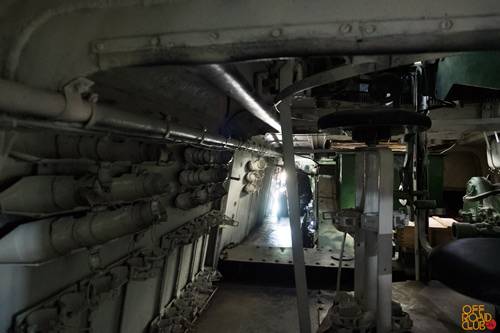
Inside, the corps was divided into seven sections - the first and second towers, the anti-aircraft machine-gun unit, the commander and radio operator, the searchlight, the third tower, and the power pack. For landing the crew had three doors - two in the sides in the middle and one in the right rear.
In the middle of the corps there was a command post, which housed the driver’s position No. 1 and the place of the commander. The latter monitored the battlefield through a range finder in a special turret, a PTK device, and a 10 multiple stereo tube.
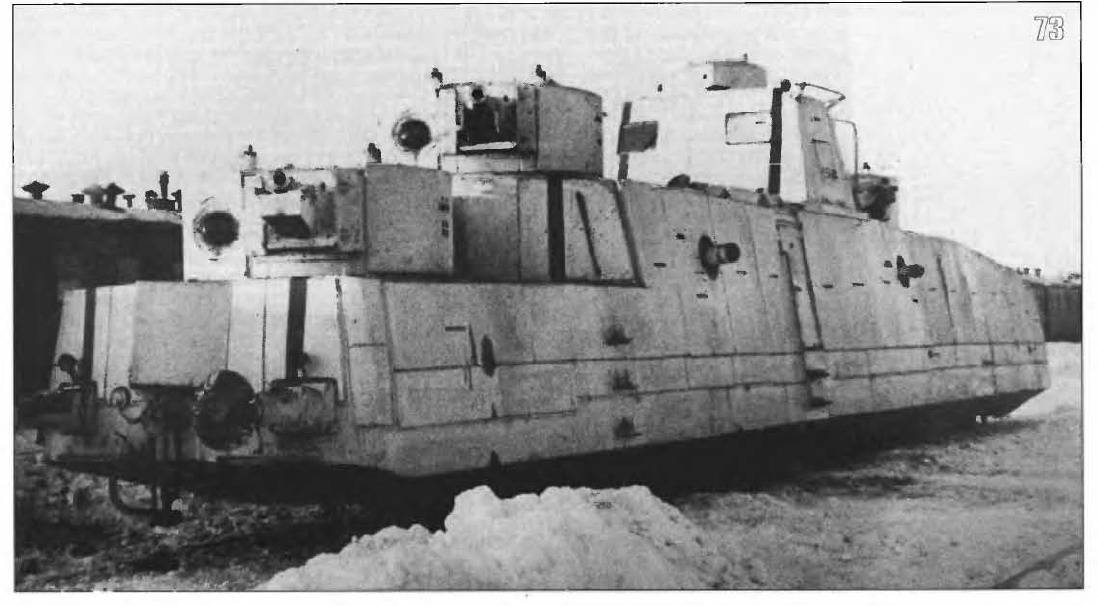
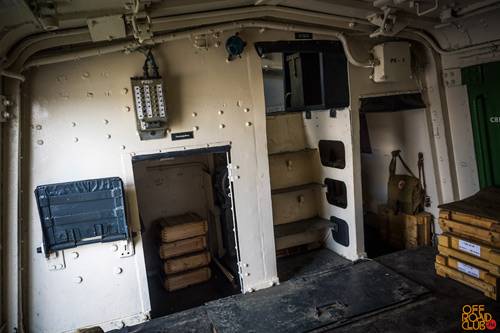
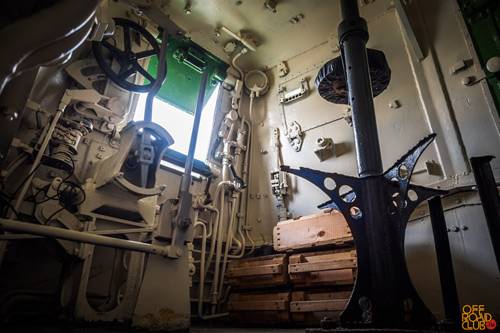
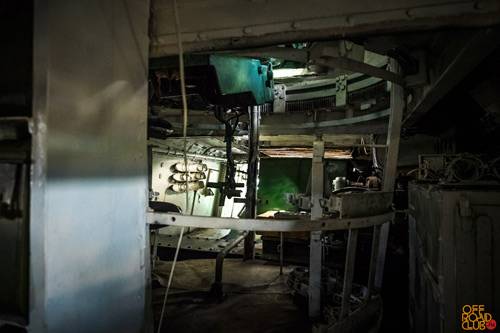
Under the commander's station there was a radio room with a radio station 71-TK-2, the handrail antenna of which was attached around the commander's cabin.
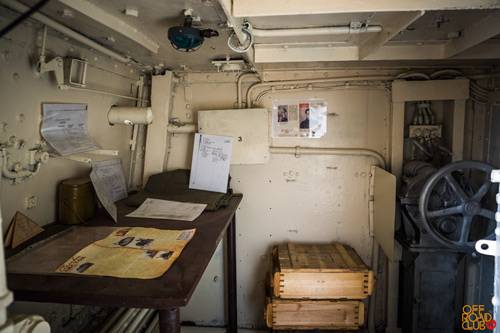
Behind the commander's cabin there was a searchlight compartment, in which there was a retractable searchlight of marine type. In addition, traveling spotlights with armored covers were installed in the front and rear walls of the body of the armored wagon, and night-fired headlights were mounted on the gun turrets.
The internal communication of the moto armor carriage was carried out using a marine-type telephone communication kit for 10 subscribers, which included two switches - in the commander's room and in the gun turret No. 2, the radio operator's and subscriber's apparatus in the radio room.
Motobronevagon equipped with a set of brakes with manual, air and electric drive. Power supply was carried out from two dynamos, as well as from eight batteries.
The design of the second model of the moto armor carriage was almost identical to its predecessor - the towers of the T-28 tank with KT-28 cannons also stood on the second model. MBE # 02 had a modernized gearbox, improved internal equipment design, internal SPU-7р communication to 10 subscribers.
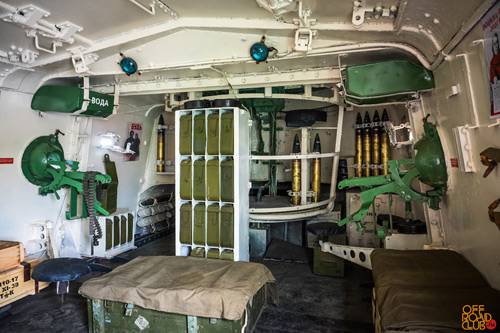
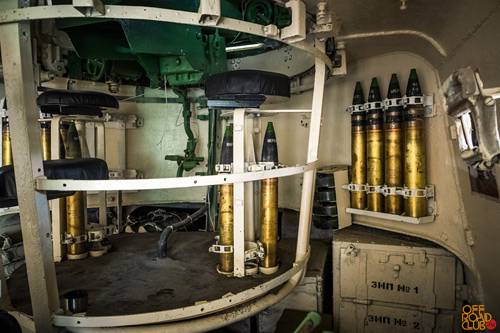

In the course of the hostilities, different colors were used for motorized wagons. A rather vivid example is sandy-pink striped camouflage. It was used in a wooded area on a granite embankment of railway tracks.
As you can see, in the absence of the necessary knowledge, armored car can be easily mistaken for any "light armored train." Four or even five cars is already a train, really a train. That is why in TTX MBV two speeds are indicated.
MBV was actively used during the Great Patriotic War. And, as we already wrote above, both cars. True, they fought in different directions. The first armored car of military destiny gradually pushed to the south, and the second destroyed the Germans in the north-west.
Let's start with BTV number 1.
By the beginning of the war, the modernization of the car at the Kolomna Plant was not completed. However, already 25 July 1941, he was sent to Moscow at the Podolsk plant. There was a reinforcement of armor protection - screening of armor case 15-20-mm armor plates (the total thickness of armor was 30-40 mm).
After the formation of a temporary crew (2 composition - 64 person) armored car was sent to the disposal of the reserve regiment of armored trains. In December, 1941 of the year became part of the 30 division of armored trains.
28 February 1942, the 30-th separate division of armored trains received orders to descend to the North-Western Front, and by March 5 it concentrated on the station Bylchino of the Kalinin railway and became part of the 34-th army.
In the period of March 16-18, armored trains supported the advance of the infantry to Lychkovo station. March 18 as a result of the X-NUMX bombers of the Ju-9 BOM aircraft No.88 was damaged and was withdrawn to be restored at the Yaroslavl steam engine repair plant.
May 23 division departed to Moscow, and from there 14 July 1942 of the year - in the 28-th army of the Stalingrad military district. August 20 division arrived in Astrakhan, and August 27, having crossed the Volga, took up a position at the junction of the North Caucasus and Stalingrad fronts.
3 September 1942 of the battalion armored trains reflected the attempt of the German units to cut the Kizlyar-Astrakhan railway, and then until the end of November 30 ODBP covered the railway from air attacks.
15 April 1943, the division was handed over to the 44 Army of the Southern Front, and he occupied the Rostov-Taganrog sector. During June-August, armored trains of the battalion were fired by infantry units, fired upon German rears, boats at sea, and targets in Taganrog. 29-30 August 30 ODBP supported the Soviet units, leading the battle for Taganrog, after which he was brought to Rostov.
From September 25 to 7 December 1943, the MBV No. 01 motobroner was being repaired at the Tambov Locomotive Repair Plant, after which the 30 Division joined the 51-th Army of the 4-th Ukrainian Front and fired German position at the 1944-th XNUMX Army of the Ukrainian Front until April XNUMX fired German position on the German positions and fired German positions on the German positions of the XNUMX-th Ukrainian Front and fired German positions on the Tambov XNUMX XNUMX XNUMX XNUMX of the Ukrainian Front.
9-11 April 1944, the 30 Division supported the offensive of our units on the Chongar isthmus, and after breaking through the German defense and liberation of the Crimea in May, it became part of the Separate Maritime Army and concentrated in Simferopol.
No less interesting is the fate of the second car.
It was this car, which was in storage at the military warehouse №37 (Moscow), it was decided to test in combat conditions. After repairs at the Kirov Plant (from 22 December 1939 of the year to 4 of January 1940 of the year) and the formation of the crew from among the trainees of refresher courses for the commanding staff of the MBV armored forces, was sent to the Karelian Isthmus, at the disposal of the 7 Army of the North-Western Front.
The BIA acted independently, supporting the offensive of its troops in the area of Perk-Järvi station with artillery fire. But March 8 MBE No.02 gave the 8-th separate division of armored trains. Since 10 in March, the BIA has been suppressing the firing points of the Finns from open positions in the area of the Liepatta station, distracting themselves with the fire of several artillery and mortar batteries.
Since the beginning of the Great Patriotic War, the MBR No. XXNX moto-armored car was urgently brought to a combat-ready state. At the beginning of July, 02 was formed for him by a crew of fighters and commanders of the LTCCU, and from July 1941 it was attached to the armored train No. 20 for joint operations.
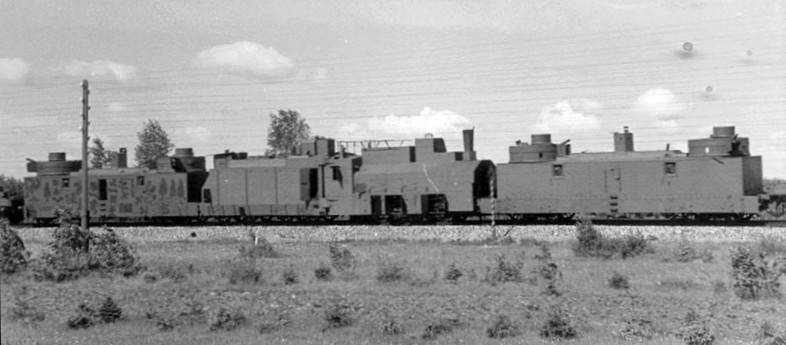
Up until the beginning of August, the BIE No. XXUMX and the armored train No. 02 were supported by our units in the Kingisepp-Moloskowice and Yastrebino-Moloskowice sections. 60 August motobronewagon was subjected to intensive shelling by German artillery, which destroyed the railroad tracks, but was able to get out of the shelling zone.
On August 18, the BIE and the armored train No. 60 were transferred to the Chudovo station area, where they became part of the armored trains of Major Golovachev. From 21 to 29 in August 1941 of the year, the motor-armored wagon as a member of the group maintained fire with their guns on part of the 48 Army.
30 August departed for repairs in Leningrad. After the repair, MBV No. 02 remained in Leningrad, and the armored train No. 60 after the transfer of Mgi went to Kirishi and later became part of the troops of the Volkhov front.
Further, the military fate of the armored car until the end of the war is closely linked with the city of Lenin. Almost all the most significant blockade operations in the list of this machine. and an infinite number of repairs. But there is one detail that I really want to draw the attention of readers.
The detail is probably irrelevant. Especially considering the sea soul of Leningrad. And maybe substantial. For the same reason. By the directive of the headquarters of the Leningrad Front of January 24, 1943, the 14th separate division of armored trains was formed, which included the former armored train No. 30 “Resistant” of the Red Banner Baltic fleet and motorized armored vehicles MBV No. 02, later named Swift.
Moreover, the MBV No. XXNX motor-bronze wagon became an armored train! And even got your own number! Armored train number 2 "Swift"! It sounds ...
The 14-th separate division of armored trains until August 1943 supported artillery fire units of the 23-th army, from August to December operated at Sinyavino as part of the 67-th army.
In December, 1943, the division was included in the 53 Army, and since January, 1944, participated in the battles to lift the blockade of Leningrad in the areas of Kolpino, Sablino, and Krasny Bor. At this time, the armored train number 684 "Swift" commanded by Captain L. Dochenko.
During repairs at the Stalin plant in the summer of 1943, MBB No. 02 was re-equipped, replacing the L-11 guns with the 76-mm tank F-34.
In May - June 1944, the 14 Division of armored trains supported the 21 Army in the Sestroretsk direction with artillery fire, then until August covered the restoration of the stations and the railway from air attacks.
26 January 1945, the 14 Division of armored trains from the station Leningrad - Navalochny departed for Vyborg, where the February 6 arrived. Here it was stationed until 10 June 1945 of the year, after which it was transferred to Leningrad, to the station Vitebsk-Sorting.
The post-war fate of the BIE is of little interest. BHE number 1 sunk somewhere in the Crimean steppes. and BIE number 2 after an unsuccessful upgrade was eventually sent to Kubinka.
It remains to recall the tactical and technical data of these little-known, but truly combat motocars:
Length: 19,2 m.
Booking:
front sheets of hull, turret and commander's cabin: 20 mm;
side sheets - 16 mm;
Roof - 10 mm.
Combat weight: 80 t.
Armament: three tank guns of caliber 76,2 mm, quadruple anti-aircraft installation 4М (4 "Maxim"), two anti-aircraft machine guns DT and two machine guns Maxim on each side;
Engine: M-17T horsepower 500 (368 kW);
Maximum speed: 120 km / h;
Maximum speed with railway train: 100 km / h;
Power reserve: 500 km.
Crew: 34 person, including 4 officer (commander, deputy commander, commissioner and assistant commander for technical support).
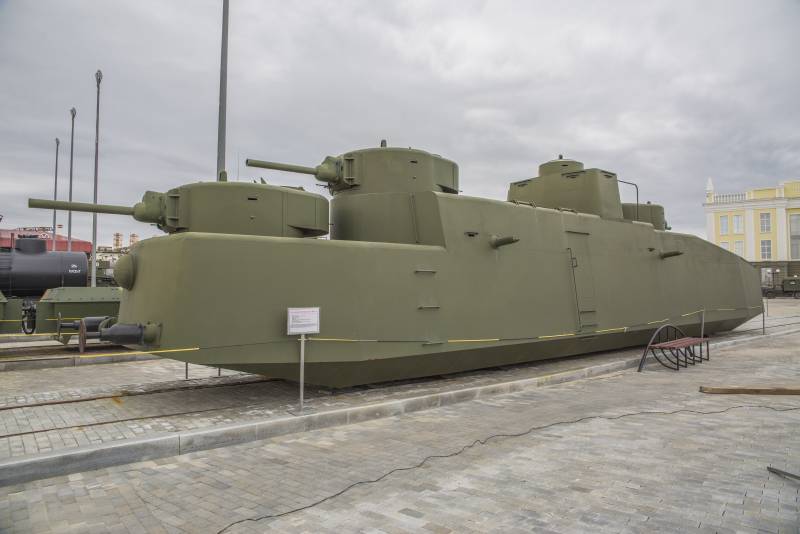
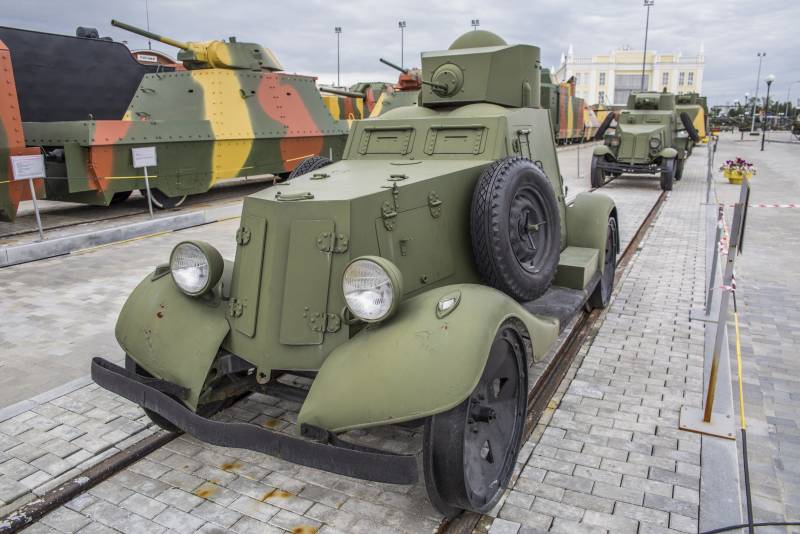
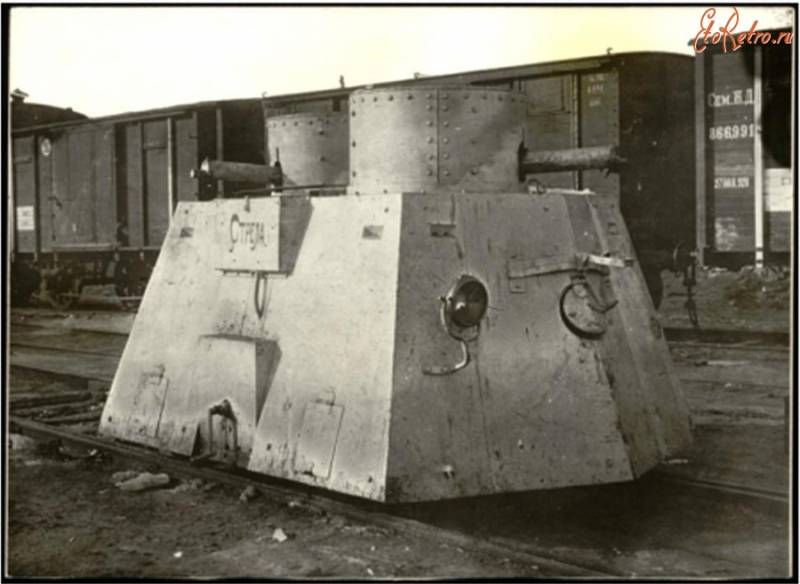
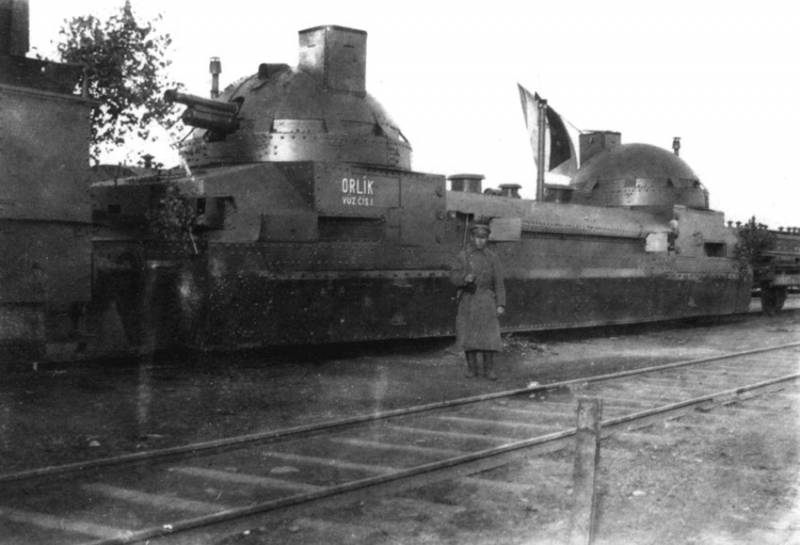
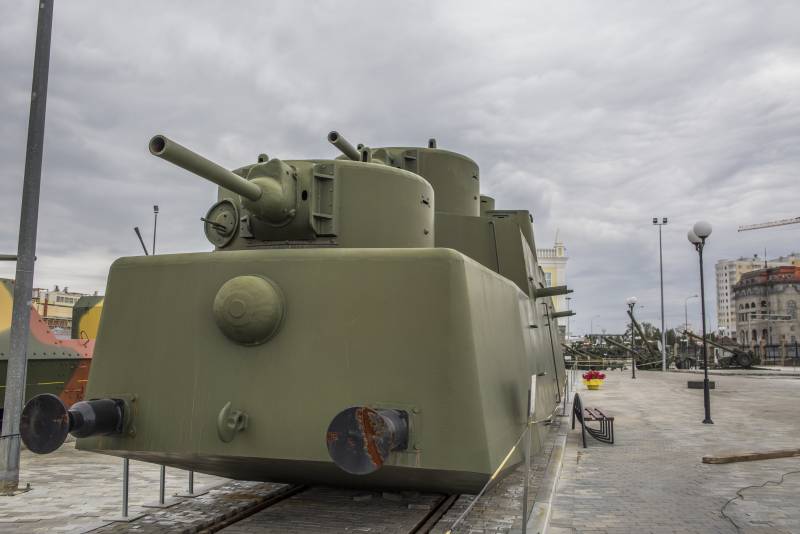
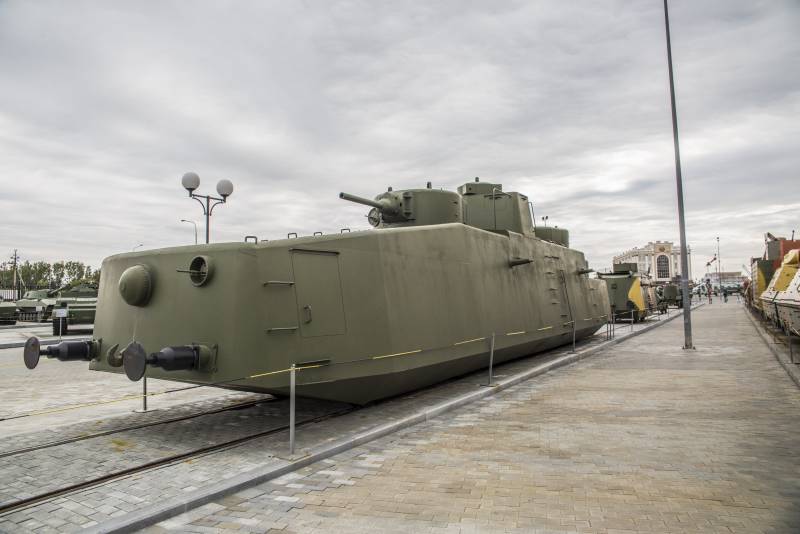
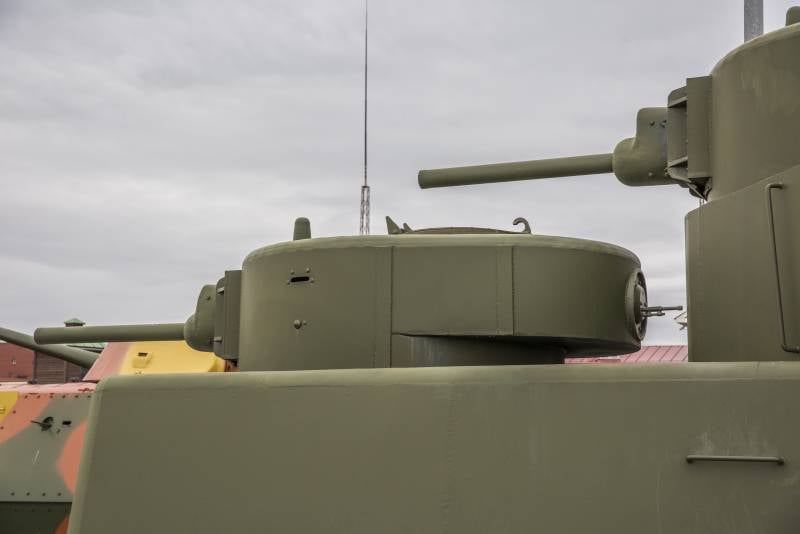
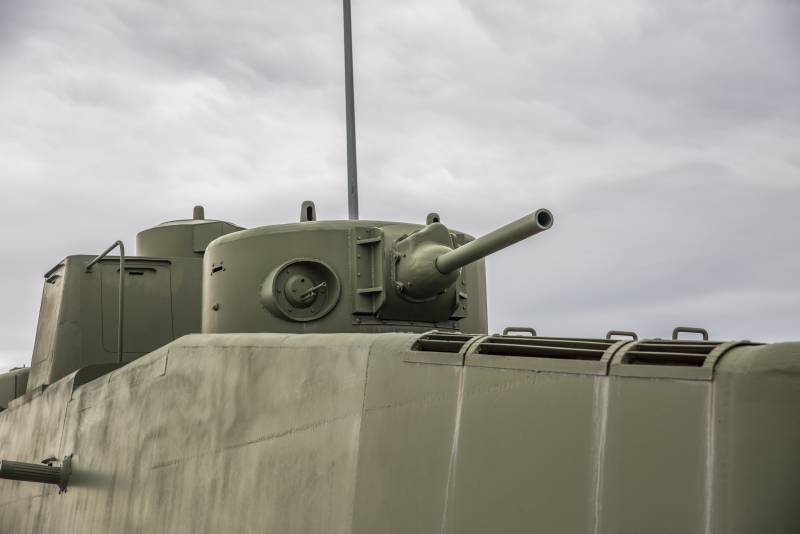
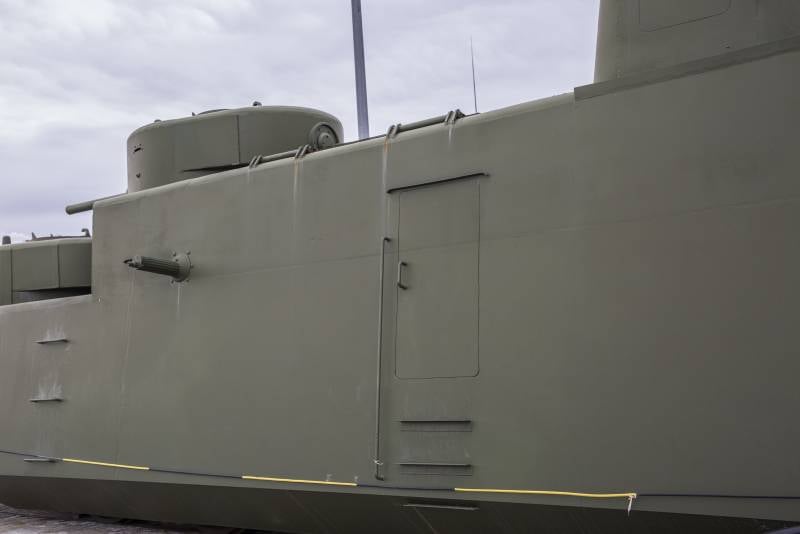

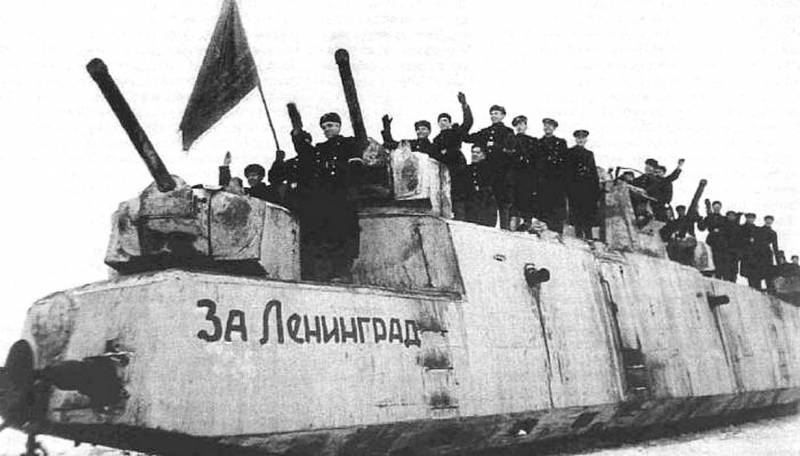
Information